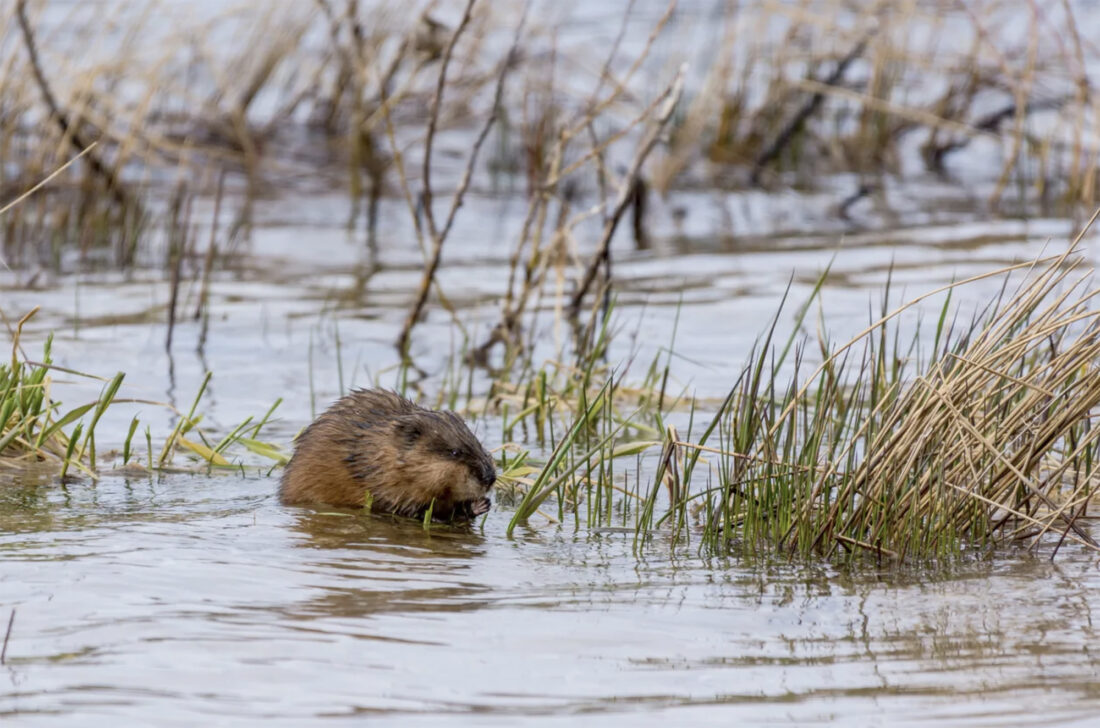New tool in fight against Great Lakes invasive species: muskrats

A muskrat eating vegetation. (Photo via Kirk Hewlett/iStock)
LANSING– In the battle against invasive species, the common muskrat emerges as an unlikely hero.
A new study in the journal Freshwater Science sheds light on these oft-overlooked rodents and their ecosystem-altering behaviors – and how humans might replicate their actions to combat invasive aquatic plants.
Cattails are a familiar feature of Great Lakes wetlands, yet the dominant species is not native to the region.
“The thing that’s unique about invasive cattails compared to many of the other invasive plants that we see is that it’s been present for over 100 years in the Great Lakes region,” said Shane Lishawa, a research associate at Loyola University in Chicago and the study’s lead author.
“And so, we have this perception that that’s the way these wetlands have always been. You look at a children’s book and there is the image of a cattail.”
Invasive cattails and other interlopers crowd out native plants, reducing biodiversity.
Enter the muskrat: At about 2 feet long from snout to tail and weighing just under 5 pounds, these semi-aquatic herbivorous mammals construct lodges out of vegetation and burrow into riverbanks for shelter.
In the creation stories of the Great Lakes Ojibwe Nations, Wazhashk – the muskrat – gives its life to collect a ball of mud from the depths, forming the island on which life can survive.
Scientists from the Sault Ste. Marie Tribe of Chippewa Indians collaborated with Lishawa and others on the muskrat study, which Lishawa said was inspired by years of observing muskrats alter their environment.
At their study site in Munuscong Marsh, located in Chippewa County in the eastern Upper Peninsula, the researchers used drones to identify muskrat lodges and measure the vegetation surrounding them.
They found that muskrat activity successfully removed the cattails and another invasive plant called European frogbit.
“The muskrats were creating these openings that had lower plant density. They’re reducing the invasive plant dominance around where they’re active,” Lishawa said.
In the open spaces left behind, native aquatic flora was able to re-establish itself.
The muskrats’ engineering prowess warrants consideration for ecosystem management, the study argued.
Of course, not every wetland area has muskrats.
In fact, the muskrat population in North America is declining, Lishawa said.
Scientists aren’t entirely sure of the reasons why, but habitat loss and water level control could be factors.
A 2017 study examining historical muskrat harvest data in the United States noted substantial population declines between 1970 and 2012, with some states experiencing muskrat reductions of more than 90%.
Lishawa and the research team investigated how alternative, human-based forms of invasive plant control stacked up against the muskrats.
“We wanted to see if we could enhance or re-create that sort of impact that the muskrats have on these wetlands through mechanical means,” Lishawa said.
These “muskrat disturbance analogues,” or MDAs, included underwater weed-whackers and herbicides targeting the cattails and European frogbit.
Both muskrats and MDAs were effective at reducing invasive plant biomass.
However, the researchers noticed some differences in muskrat vs. human handiwork.
For example, muskrats provided the added benefit of acting as wetland janitors, cleaning up the dead plant material that acts as fuel for cattail incursions.
Muskrats were also more effective than MDAs at reducing European frogbit.
Lishawa said he hopes that future research will expand on the study’s findings, perhaps by investigating more wetland sites and observing how muskrat population changes impact the Great Lakes.
“These are sort of like, ‘lowly’ creatures,’ and I think that it’s really easy for people to discount the sort of importance of creatures like muskrats that are often considered pests,” Lishawa said, adding that we should “appreciate (muskrats’) role in our ecosystem and their role in maintaining the function of the Great Lakes system and maintaining the biodiversity of the system.”
———
This story was originally published by the Capital News Service at Michigan State University.



